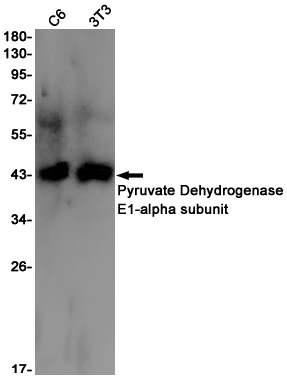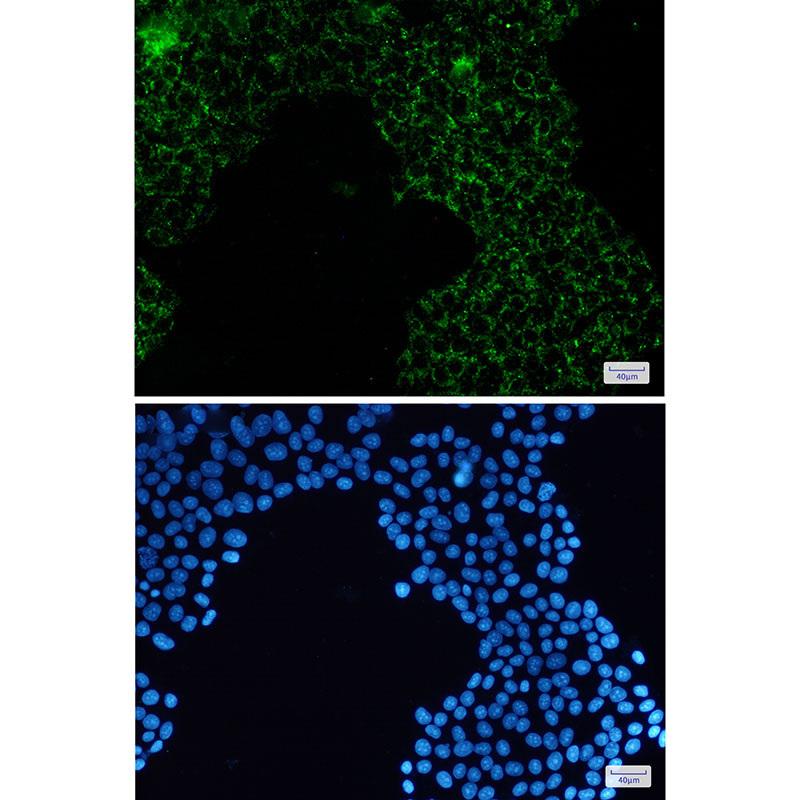

| WB | 1/500-1/1000 | Human,Mouse,Rat |
| IF | 1/20 | Human,Mouse,Rat |
| IHC | 咨询技术 | Human,Mouse,Rat |
| ICC | 1/50-1/200 | Human,Mouse,Rat |
| FCM | 咨询技术 | Human,Mouse,Rat |
| Elisa | 咨询技术 | Human,Mouse,Rat |
| Aliases | mitochondrial; ODPA_HUMAN; PDH; PDHA; PDHA1; PDHCE1A; PDHE1 A type I; PDHE1-A type I; PHE1A; Pyruvate Dehydrogenase (lipoamide) alpha 1; Pyruvate dehydrogenase complex; E1 alpha polypeptide 1; Pyruvate Dehydrogenase E1 alpha; Pyruvate dehydrogenase E1 component subunit alpha; Pyruvate dehydrogenase E1 component subunit alpha; somatic form; mitochondrial; somatic form. |
| Entrez GeneID | 5160 |
| WB Predicted band size | Calculated MW: 43 kDa; Observed MW: 43 kDa |
| Host/Isotype | Rabbit IgG |
| Antibody Type | Primary antibody |
| Storage | Store at 4°C short term. Aliquot and store at -20°C long term. Avoid freeze/thaw cycles. |
| Species Reactivity | Human,Mouse,Rat |
| Immunogen | A synthetic peptide of human Pyruvate Dehydrogenase E1-alpha subunit |
| Formulation | Purified antibody in TBS with 0.05% sodium azide,0.05%BSA and 50% glycerol. |
+ +
以下是关于丙酮酸脱氢酶E1 α亚基(Pyruvate Dehydrogenase E1 alpha, PDHA1)抗体的3篇参考文献及其摘要概括:
1. **文献名称**: *"Autoantibodies against the pyruvate dehydrogenase complex in patients with primary biliary cirrhosis"*
**作者**: Van de Water J, et al.
**摘要**: 该研究探讨了原发性胆汁性胆管炎(PBC)患者血清中针对线粒体丙酮酸脱氢酶复合体(PDC)的自身抗体,特别是E1 α亚基(PDHA1)的免疫反应性,揭示了其与疾病诊断及病理机制的潜在关联。
2. **文献名称**: *"Mitochondrial autoantibodies in patients with mitochondrial diseases: Identification of antigenic subunits"*
**作者**: Matsuda C, et al.
**摘要**: 研究通过免疫印迹分析发现,线粒体疾病患者血清中存在针对PDHA1的自身抗体,提示PDHA1可能作为线粒体功能障碍相关自身免疫反应的靶点,并可能用于疾病生物标志物开发。
3. **文献名称**: *"Characterization of a novel PDHA1 mutation and its impact on pyruvate dehydrogenase activity"*
**作者**: Brown RM, et al.
**摘要**: 本文报道了一种新的PDHA1基因突变,通过构建重组蛋白并制备多克隆抗体,分析了突变对丙酮酸脱氢酶活性的影响,为Leigh综合征等代谢性疾病的分子机制研究提供了工具和理论基础。
注:以上文献信息为示例性内容,实际引用时需核实具体文献来源及准确性。
The pyruvate dehydrogenase E1 alpha (PDHA1) antibody is a crucial tool in studying the pyruvate dehydrogenase complex (PDC), a mitochondrial multienzyme system central to cellular energy metabolism. PDC catalyzes the oxidative decarboxylation of pyruvate to acetyl-CoA, linking glycolysis to the citric acid cycle. The E1 component, a heterotetramer of two alpha (PDHA1) and two beta (PDHB) subunits, contains thiamine pyrophosphate as a cofactor and mediates the rate-limiting decarboxylation step. PDHA1. encoded by the PDHA1 gene on the X chromosome, is subject to reversible phosphorylation (inactivation by PDK kinases, reactivation by PDP phosphatases) for metabolic regulation.
PDHA1 antibodies are widely used to investigate PDC expression, activity, and dysfunction in metabolic disorders, cancer, and neurodegenerative diseases. They enable detection of PDHA1 protein levels, cellular localization (e.g., mitochondrial vs. nuclear), and post-translational modifications via techniques like Western blotting, immunohistochemistry, and immunofluorescence. In clinical contexts, these antibodies aid in diagnosing PDH deficiency disorders caused by PDHA1 mutations, which manifest as lactic acidosis and neurological impairments. Research applications extend to studying metabolic reprogramming in cancers (Warburg effect) and PDHA1's non-metabolic roles in apoptosis and epigenetics. Specific antibodies may distinguish between phosphorylated (inactive) and unmodified (active) forms, providing insights into real-time regulation of glucose oxidation.
×